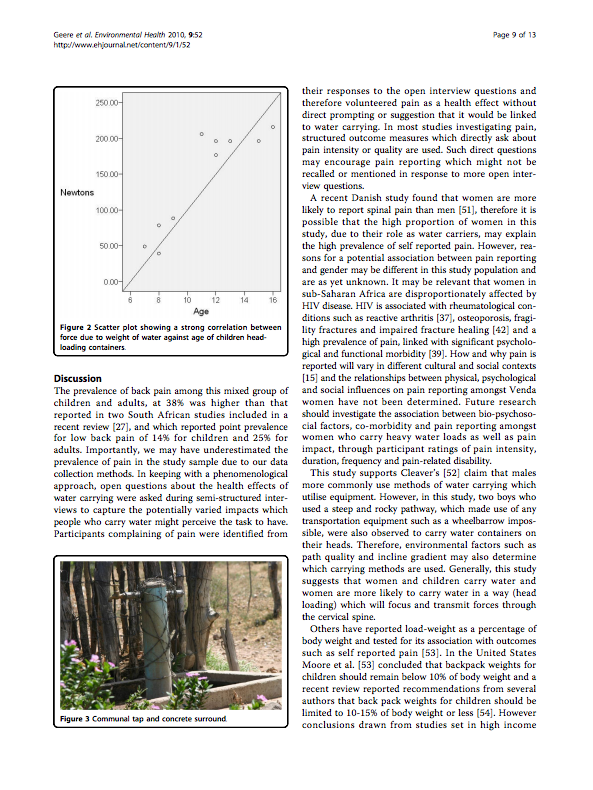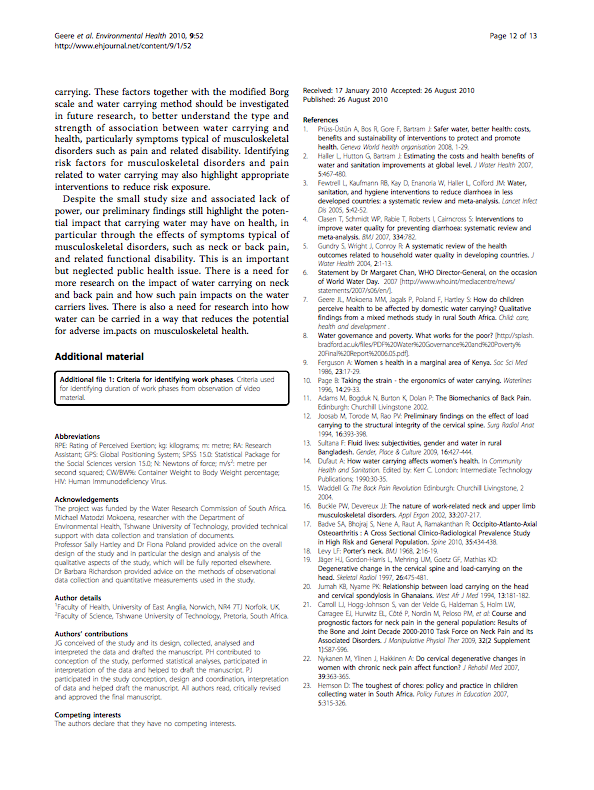Today while completing the research tasks ready for the next group meeting I came across a research paper that reviewed the health implications of domestic water carrying in African provinces.
Compared to the research I have collected up to this point in the project, the research paper presents the most relevant body of information reviewed thus far, as it specifically discusses an aspect of the problem featured on the 'Water For All' brief, reducing the strain put on women and children collecting water.
The study is very comprehensive and lists the methods used to collect data in detail while also outlining the limitations of the study. For these reasons, I am fairly confident that the information featured in the research paper is reputable, unbiased and therefore an appropriate source of secondary information.
RESEARCH PAPER
Images below document the pages from the report. While reading through its content I made note of any important or relevant information, evidence of which can be found underneath each image.
IMPORTANT POINTS;
- There has been little research into the health effects of frequently carrying containers of water.
- The aim of the study is to identify;
- How water carrying is performed.
- Outline the potential health risk factors.
- Gain an insight into the possible health effects of the task.
- Data was collected from six rural villages in South Africa.
- Data was collected through semi-structured interviews, observations and measurement.
- Water carrying was mainly performed by women and children carrying containers on their head (mean container weight was 19.5kg over a mean distance of 337m).
- The prevalence of spinal pain was 69% and back pain was 38%.
- Of participants who carried water by head-loading, the distance walked by those who reported spinal pain was significantly less than those who did not.
- Typical water carrying methods impose physical loading with the potential to produce musculoskeletal disorders and related disabilities.
- The study is limited by the small sample size.
- Preliminary finding suggest that the efforts should be directed towards eliminating the need for water carrying, or where it must continue, identifying risk reduction factors for the outlined injuries.
IMPORTANT POINTS;
- Water filled containers are often carried on the head.
- Transportation with wheelbarrows, animal drawn carts and rolling filled containers are also used.
- Such methods create physical demands on the body and have the potential for adverse physical stress from regularly carrying loads of water.
- Frequent loading beyond the capacity for adaptation or repair may lead to injury through fatigue failure, accumulation of fatigue damage or degenerative changes in bone and soft tissues.
- Assumptions, supported with strong evidence, suggest water carrying is detrimental to health and associated with musculoskeletal disorders such as spinal pain and other joint problems.
- Carrying heavy loads on the head by professional porters has been documented to cause catastrophic injury, such as spinal fractures, dislocation and even death.
- There is a higher prevalence of cervical osteoarthritis in porters (91.6%in male porters compared to 6.8% in the control group.
- Very few studies specifically investigated as it is performed by women & children in developing countries, instead focusing on the health impacts of physical loading of male adult workers.
- Two recent studies indicate that some people may experience high rates of perceived exertion and physical pain that can limit the amount of water they can carry, which can have serious implications for the health of their families.
- Water carrying is also a physical activity that can have beneficial health effects in some individuals - It is important to consider the health impacts broadly.
IMPORTANT POINTS;
- Mixed methods were used to collect information, utilising both quantitive and qualitative data to understand the task.
- The report focuses on the analysis of quantitive data, combined with specific findings from content analysis of qualitative data generated from semi-structured interviews.
- The approach was used to to evaluate the relationship between physical pain and potential risk factors observed to occur during water carrying.
- Data was collected from six individual villages in South Africa with high levels of poverty and suboptimal water supply.
IMPORTANT POINTS;
- Children that took part in the study were weighed, had their height measured and also the weight of the filled containers they intended to carry .
- 43 people were included in the study for collection of observational data and/or semi-structured interviews.
- Participant demographic table featured in the bottom right hand corner of the page.
IMPORTANT POINTS;
- Borg scale was used to gain insights into the intensity of work performed by participants.
- The modified Borg scale is a twelve grade category rating scale with ratio properties, which combines both verbal and numerical descriptors that can be used to measure a persons rating of their perceived exertion during a specific task.
- Content analysis of participant interview responses was used to identify regions of the body where pain was occurring and was used to calculate the prevalence of spinal pain, back pain and neck pain.
- It was also used to determine subgroups of participants who did and did not report pain.
IMPORTANT POINTS;
- Two techniques were used to gain insight into the intensity of work participants engaged with.
- Firstly, participants rated their level of perceived exertion using the Borg scale.
- Secondly, the weight of water carried was calculated as a percentage of body weight for all carrying methods in Newtons of force.
- Force in Newtons is equal to mass multiplied by gravity.
- Linear regression modelling was used to identify significant correlations between variables and self reported pain.
- Three methods of carrying water were observed;
- Head loading of water filled containers (N = 30)
- Rolling a water filled drum (N = 2)
- Pushing a wheelbarrow weighted with water filled containers (N = 7)
- Women most commonly used head loading to carry water - 82% of female participants chose the method compared to 40% of the males.
- Potential Health Impacts;
- Pain was commonly reported as an effect of carrying water in the semi-structured interviews.
- 69% of study participants reported spinal pain - defined in this study as pain reported or indicated through gesture by participants to be in the head, neck, thoracic or lumbosacral region.
IMPORTANT POINTS;















No comments:
Post a Comment